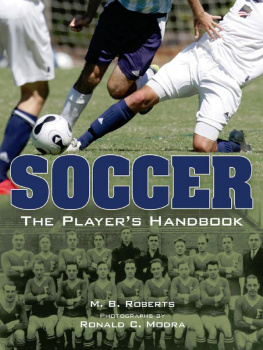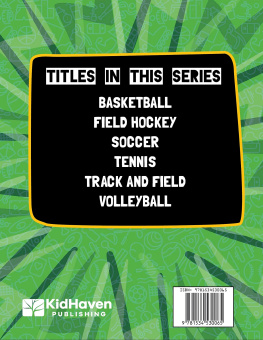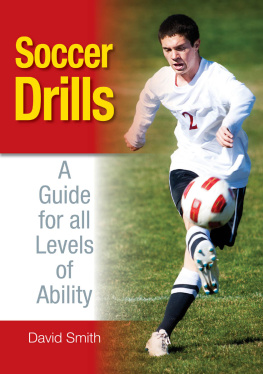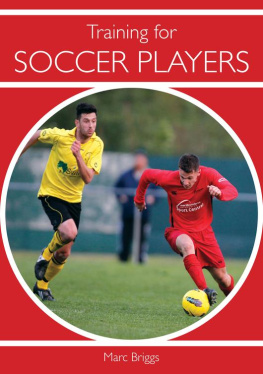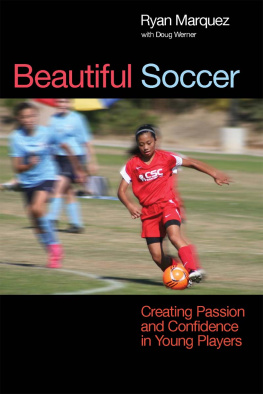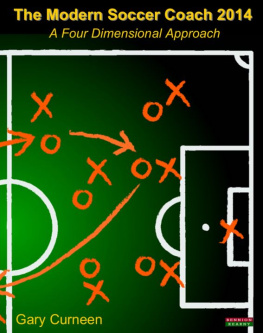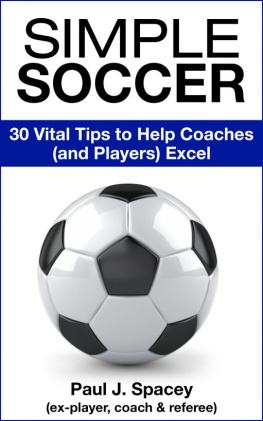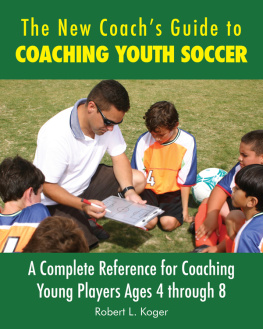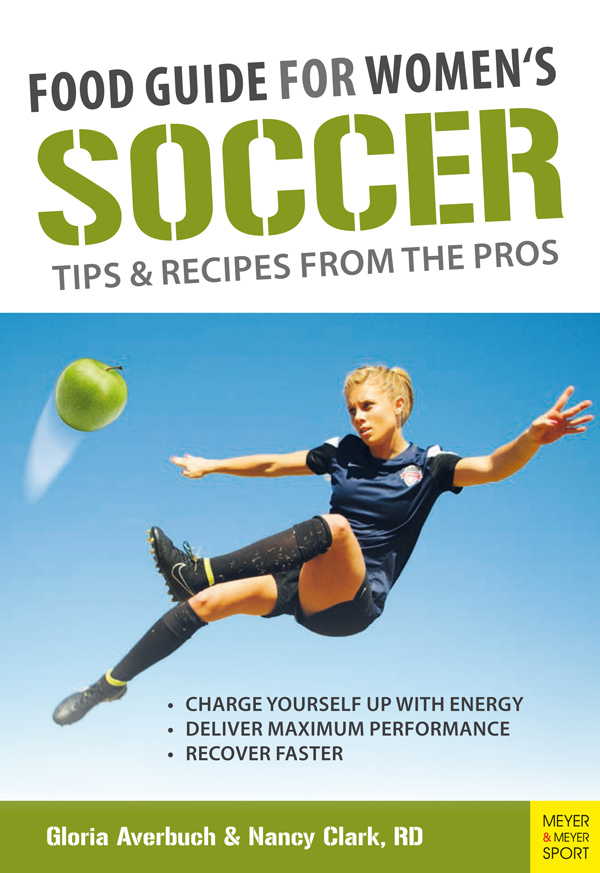
Gloria Averbuch / Nancy Clark
Food Guide for Women's Soccer
Tips and Recipes from the Pros
Meyer & Meyer Sport (UK) Ltd.

Contents
Imprint
2015 by Meyer & Meyer Sport (UK) Ltd.
Aachen, Auckland, Beirut, Cairo, Cape Town, Dubai, Hgendorf, Hong Kong, Indianapolis, Manila, New Delhi, Singapore, Sydney, Teheran, Vienna
Member of the World Sport Publishers Association (WSPA)
978-1-78255-393-9
www.m-m-sports.com
ISBN 978-1-78255-393-9
DISCLAIMER
The information in this book is not intended to replace the personalized nutrition and medical advice that is best offered on an individual basis with your health care providers. Personalized medical and nutritional advice should be sought from a competent health professional in your local area. The authors and publisher of this book have made all best professional effort to prepare it, as well as the advice contained within it. Neither the author nor the publisher will be liable for possible disadvantages or damages resulting from this book.
Acknowledgments
Food Guide for Womens Soccer: Tips and Recipes From the Pros includes the contributions of women professional soccer players who were members of the Womens Professional Soccer league. While that league has since been replaced by another version (National Womens Soccer League, NWSL), the majority of the players featured in the book (some last names changed due to marriage) are still active professionals, many of them in NWSL. Their nutrition tips and recipes included in the book are top-notch, and represent a long track record of soccer, sports and life success.
We acknowledge and thank: Cori Alexander (photos) and Robyn McNeil (Photo Editor); Doron Tamari, for research and invaluable player interviews; Nancys and Glorias family for being patient recipe testers.
Dedication
To all aspiring soccer starsEat wisely and well, and win with good nutrition!
Gloria Averbuch
Nancy Clark RD
Foreword
The Soccer Journey
Learning how to fuel for soccer is a meaningful and lifelong habitone of the many that a soccer education provides for young people. I have seen it time and again. Most prominently, I can recall an early incident that helped inspire Food Guide for Womens Soccer. It was the day I overheard a 10-year-old player who had learned the benefits of eating according to the principles of this book. She spontaneously declared aloud, I will never drink another soda again! She understood that fueling wisely for sports, as well as for life, is in her best interest.
My adult daughters have played soccer since early childhood. Soccer has defined their lives through college, and has taken them all over the world. One is a currently a professional player, and the other still plays avidly in adult leagues and works for Major League Soccer (MLS). They are lifelong beneficiaries of the game.
Female soccer players all over the country mirror their passion. Those of us involved in soccer experience the excitement for the beautiful game, as it is often called, when we watch the players. We see it on the faces of the young girls, the families, the fans, and everyone involved in the sport.
When people ask What is the greatest benefit of participating in soccer (and any other sport, for that matter)?, I offer this answer: the most fortunate among us are those who can possess and nurture a passion. For millions, both here and around the world, soccer is the vehicle for that passion.
I dedicate this book to all those who are passionate about soccer, and to the many people who have brought their talents, energy and generosity to the game.
Gloria Averbuch
Section I
Day-to-Day Eating for Energy
Chapter 1
Daily Eating for Health and High Energy
Eating with a purpose, and also with enjoymentthats what nutrition for soccer is all about! Good food is not only one of lifes pleasures; it is also a powerful tool for helping you to be a better soccer player. Eating the right foods at the right times can help you train at your best so you can then compete at your best. It will also improve your health and future well-being. Unfortunately, eating well on a daily basis doesnt just happen magically. You need to understand good nutrition, and find time to food shop, so youll have wholesome sports foods available.
You also need to find time to fuel up and refuel with an eating schedule that enhances your energy and improves your performance. Unfortunately, the chaos of training and general schedules that lead to erratic eating patterns may result in losing track of what you haveand have noteaten.
In this chapter, you will learn the basic tips about how to eat well, even when you are eating on the run. But first, it helps to understand what "eating well" means. A simple definition is to eat:
At least three kinds of wholesome foods at each meal.
At least two kinds of wholesome foods for each snack.
Evenly-sized meals about every four hours throughout the day (as opposed to "crescendo eating" with a small breakfast and a large meal at the end of the day).
At least 90 % of the calories from quality foods and, if desired, the remaining 10 % from sweets and treats.
Luckily for todays soccer players, you (or your parents) dont have to be a good cook to eat well. You can still manage to nourish your body optimally even if you are dashing from school or work to workout, and are spending very little time in the kitchen.
Some Top Sports Foods
The following top sports foods offer mainly cook-free and convenient best bets for soccer players (and their families) who eat and run.
Some of the best fruits for vitamins A and/or C or potassium:
Oranges, grapefruit, cantaloupe, bananas, apricots, berries, kiwi, mango
Some of the best vegetables for vitamins A and/or C:
Broccoli, spinach, kale, green and red peppers, tomatoes, carrots, sweet potato, winter squash
The easiest sources of calcium for strong bones:
Low-fat milk, yogurt, cheese, calcium-fortified orange juice, soy milk, and tofu
Convenient cook-free proteins for building and protecting muscles:
Deli roast beef, ham, and turkey, canned tuna and salmon, hummus, peanut butter, tofu, cottage cheese
Cook-free grains for carbohydrates and fiber:
High-fiber breakfast cereals (preferably iron-enriched), wholesome breads and bagels, whole-grain crackers
Here are some guidelines to help you make optimal food choices:
Try to eat at least 2 cups of fruit and 21/2 cups of vegetables per day.
Choose a variety of colors of fruits and vegetables each day: red apples, green peppers, orange carrots, yams, or bananas. If you cant eat them, drink 100 %-fruit and/or vegetable juices.
Enjoy whole-grain products at least two times per day, such as oatmeal for breakfast and whole wheat bread for lunch. The rest of the recommended grains can come from enriched grain products, such as enriched pasta. In general, at least half the grains should come from whole grains. (Whole grains include whole wheat, brown rice, oats, corn, barley, etc.)
Drink 3 cups (24 ounces; 720 ml) each day of fat-free or low-fat (soy) milk or yogurt, or eat the calcium-equivalent in low-fat cheese (1.5 ounces (45 g) of cheese = 8 ounces (240 ml) of milk or yogurt).


